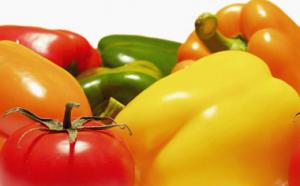Did you know that fruits and vegetables provide different vitamins, minerals, and phytochemicals according to their color?
Every September, the Produce for Better Health Foundation and the National Cancer Institute, along with other organizations, celebrate “Five a Day, the Color Way.”
“Five a Day, the Color Way” is an educational program designed to raise public awareness about the importance of eating at least five servings of fruits and vegetables a day. It also stresses the importance of varying our diet to ensure we get all the nutrients that fruits and vegetables so generously offer us. The human body only needs small amounts of vitamins and minerals. But those small amounts are essential for performing countless functions. They help us by preserving our eyesight, preventing the development of diseases like cancer, maintaining our memory, strengthening our bones and teeth, keeping our urinary tract healthy, and by keeping our heart pumping.
Phytochemicals are natural plant compounds that provide great health benefits and are responsible for the brilliant colors found in fruits and vegetables. “Five a Day, the Color Way” groups foods according to their color. The food items found in each color group provide specific phytochemicals, vitamins, and minerals.
Recognizing the categories is easy due to their highly distinctive colors:
- Blue/Purple:This group includes eggplant, plums, grapes, and blackberries.
- Green:This group includes, among others, broccoli, pears, kiwi, spinach, avocado, green apples, limes, asparagus, cabbage, squash, and lettuce.
- White:Good examples of this group include cauliflower, mushrooms, bananas, garlic, and onions.
- Yellow/Orange:This group includes oranges, corn, pineapples, peaches, passion fruit, cantaloupe, mango, and carrots.
- Red:This bright group includes watermelon, tomatoes, strawberries, and cherries.
Some people claim fruits and vegetables are simply not to their liking. When thinking of fruits and vegetables, most focus on the few that they don’t enjoy and are frequently served at home. Due to their large variety, it is possible to pick food items from each color group that will form a list of enjoyable fruits and vegetables while simultaneously fulfilling the recommended daily allowances.
Recommended daily allowances vary from person to person. Women who are not particularly active, as well as children between the ages of 2 and 6, can eat 5 servings a day (2 of fruit and 3 of vegetables). Children over the age of 6, active women, teenage women, and most men should eat 7 servings (3 of fruit and 4 of vegetables). Lastly, adolescent boys and very active men should eat 9 servings a day (4 of fruit, and 5 of vegetables).
To help you incorporate fruits and vegetables into your diet, MyDiet™ suggests the following:
- Incorporate a salad into every meal.
- Remember that fruit can be consumed as a juice or eaten whole. Some vegetables can also be made into juices.
- Soups are a good way of incorporating vegetables into your diet.
- Use vegetables and fruits, rather than fats, as the base for meat sauces.
- Eat fruit instead of sweets for dessert.
- Get your children accustomed to eating fruits and vegetables at an early age. Getting them into the habit when they are young will make it much easier for them to meet their daily requirements as adults.
- Instead of candy, make fruit and vegetable snacks.
- Prepare vegetable-based party snacks and appetizers. They are a much healthier option than the usual salty or fatty ones.
- Make fruit salad and keep it in the fridge. This way, you can combine several colors in one dish while saving the trouble of preparing a new dish every time.
- If you are going to be out the entire day, put a fruit or vegetable snack in your bag. Include them in your kids’ lunchboxes as well.
“Five a Day” is an excellent initiative. Following its recommendations only for the month of September is not enough. Get into the habit all year round and, in time, your body will thank you for it.
To help you prepare and include vegetable and fruit dishes in your diet, MyDiet™ will be publishing a number of vegetable and fruit recipes this week for you to try.
*Nutritionist from the MyDiet™ Team, President of the Venezuelan Society of Nutritional Education

